Watermelon Peperomia enchanted me with its alluring beauty, forcing me to buy one.
After a couple of months, it had developed annoying brown spots that made me question where did I go wrong.
I asked different professional gardeners, scoured the internet, tried other things, and finally got in-depth answers.
Generally, brown spots on Watermelon Peperomia can be due to overwatering, excess sunlight, bacterial and fungal diseases, and nutrient deficiency. To cure brown spots, provide 5-6 hours of indirect sunlight at 60-80°F temperature and develop a consistent watering habit.

Several factors are causing an inconvenience to your plant, so to cure, you need to understand plants’ basic requirement borderlines.
So, let us find out what causes brown spots, their treatment, and preventive measures.
Table of Contents
How to Identify Watermelon Peperomia Brown Spots?
Watermelon Peperomia is trending all over the globe with shimmering silver stripes resembling watermelon.
Unfortunately, those beautiful leaves are more prone to have annoying spots than in other parts.
Watermelon Peperomia typically develops black, yellow, and brown spots as a result of various environmental factors.
Moreover, all these spots do not come in any particular shape, size, or place.
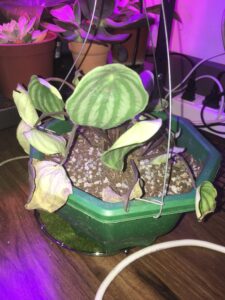
Although spots commonly appear on top of the leaves, they may also lie underneath and on the stems.
Here are the potential reasons causing different spots on your Watermelon Peperomia.
| Spot Type | Main Potential Cause |
|---|---|
| Black Spot | 1. Plant is infected with black fungus 2. Pest damage |
| Yellow Spot | 1. Excessive sun exposure 2. Overwatering |
| Brown Spot | 1. Oedema/Edema 2. Ring Spot 3. Overwatering 4. Nutrients Deficiency |
All these spots can vary from smaller sizes to bigger ones, almost covering the whole leaf.
In most cases, spots appear on the surface, inflamed, crispy, dry, or mushy leaves.
According to the research, spots interfere with photosynthesis leading to a decrease in the metabolic process rate.
It is normal for Watermelon Peperomia to form a few brown spots as they are vulnerable to many environmental factors.
But the abnormal amount of brown or other spots means it is time to reconsider their needs.
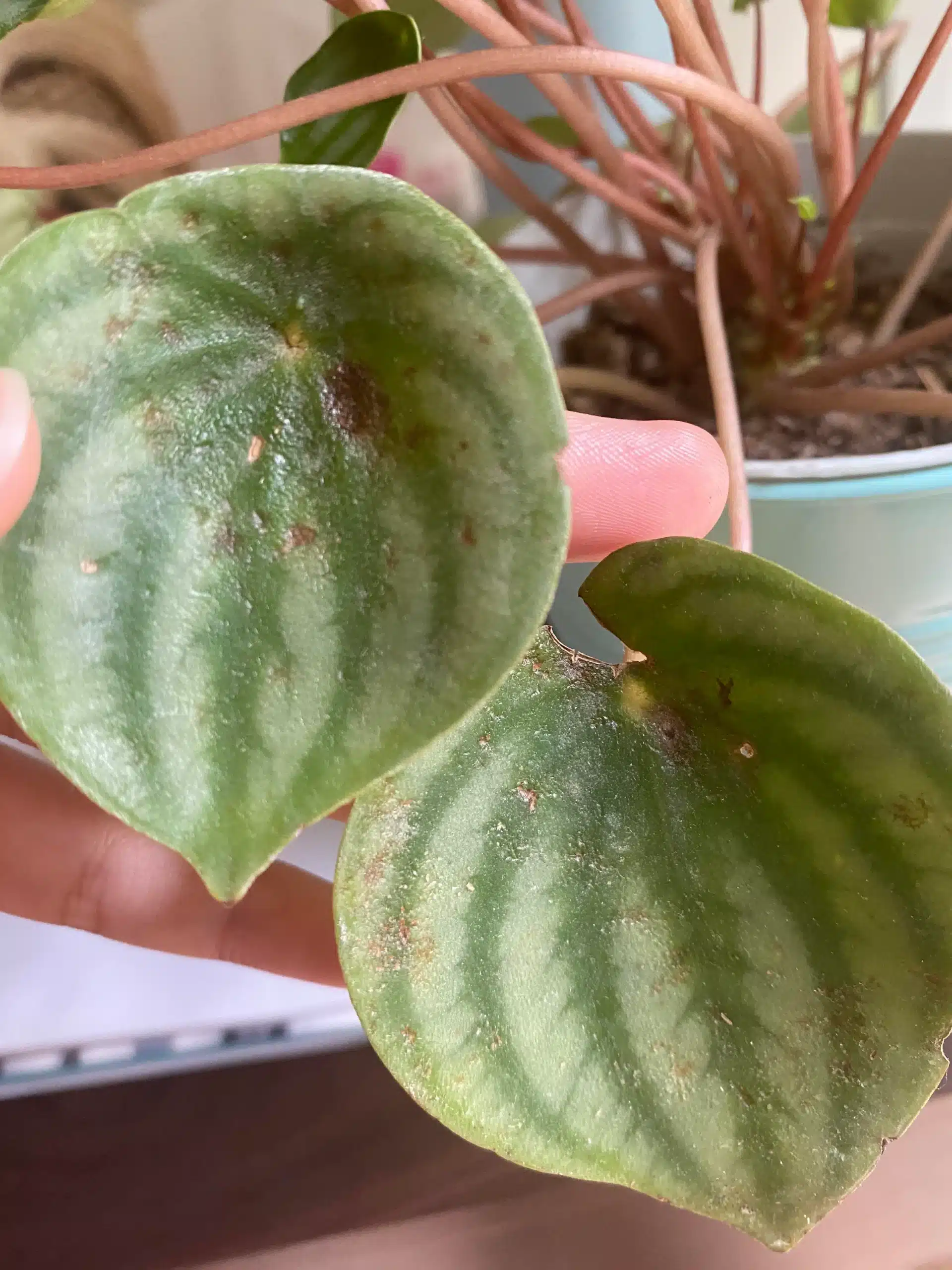
Therefore, before the brown spot spreads all over the plant, it is necessary to treat your plant on time.
Brown spots can weaken plants, causing them to lose their leaves and even cause plants to die if left untreated.
Watermelon Peperomia Brown Spots: Causes and Treatment
Watermelon Peperomia is less prone to having problems with lower maintenance but suffers when you do not fulfill their basic needs.
Here is a brief overview of the potential culprit causing brown spots on your Watermelon Peperomia.
| Causes | Solutions |
|---|---|
| Overwatering | Immediately cut back on watering and use the bottom watering technique. |
| Root Rot | Replant the Watermelon Peperomia into a new pot after removing rotted roots. |
| Excess Sunlight | Place the Watermelon Peperomia in partial shade and use curtains to drop light intensity. |
| Fungal and Bacterial Diseases | Prune off dead leaves and apply fungicides to prevent further infestation. |
| Pest Infestation | Insecticidal soaps, neem oil, horticultural oils, and pesticides. |
| Calcium Deficiency | Use eggshells and lime along with organic fertilizers. |
| Fertilizer Issues | You can replace liquid fertilizers with slow-release pellets. |
| Low Humidity | Misting the plant’s leaves with filtered or distilled water. |
| Improper Potting Mix | Repot the plant to fresh new well-draining potting mix |
| Temperature Stress | Maintain your plant temperature around 60-80°F during the daytime and above 55°F at night. |
So, ensure you read thoroughly to narrow down the real culprit and provide the respective treatment solutions.
1. Improper Watering
Generally, Watermelon Peperomia has a higher tolerance for underwatering situations than overwatering.
It prefers moist but not soggy soil, so gardeners recommend watering a bit often to maintain preferable moisture.
However, a regular watering routine leads to overwatering issues if the soil and pot do not feature proper draining functionality.
Overwatering the plant may cause Oedema. Plants can develop edema when their roots absorb more water than their leaves can evaporate.
This extra water ruptures the cells, resulting in unsightly water-soaked brown patches.
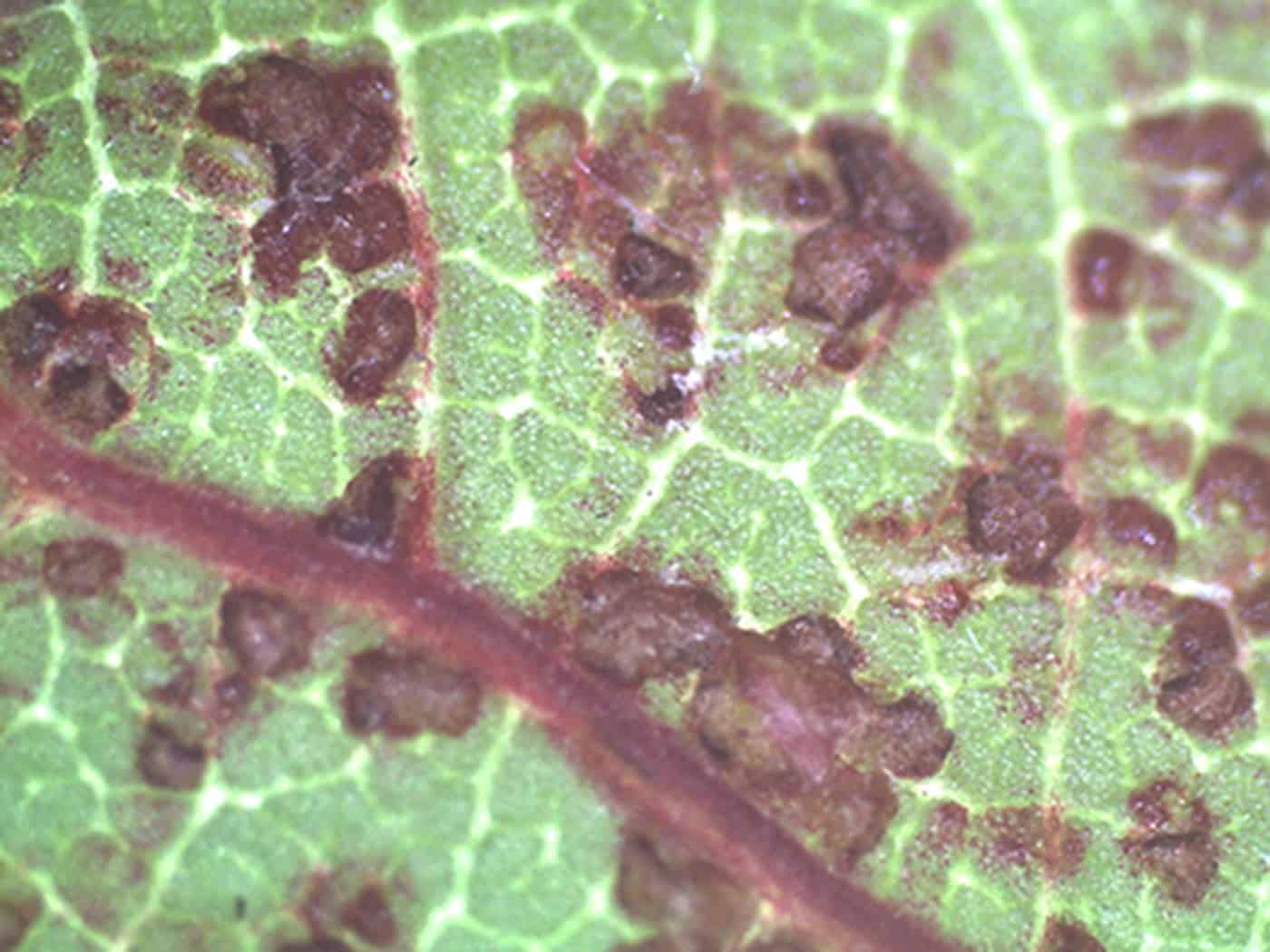
These brown spots can turn the leaves yellow, droop, and eventually fall off. Furthermore, they appear rarely on stems as well.
Fixing Overwatering Issues
- Once you notice small blisters forming on leaves, cut back on watering first.
- After that, you can balance out the water uptake by the roots via increasing water loss.

- Decreasing humidity can ultimately force your plant to increase transpiration to balance the situation.
- Increase air temperature slightly above the average temperature(80°F).
- Place them in bright indirect sunlight to fascinate faster transpiration.
- Slide the plant out and look for root rot if the problem continues for weeks.
- If the plant has severe root rot, discard it; otherwise, prune the infected areas and apply fungicide before repotting in a new soil mix.
- Water once a week in the spring and summer and once every two weeks in the fall and winter.
- Allow the top 2-3 inches of soil to dry between waterings. A slightly dry soil aids root growth.
Note: These solutions should only be performed until your plant recovers its health back.
Meanwhile, Watermelon Peperomia suffers underwatering forming brown spots and edges when you are too negligible.
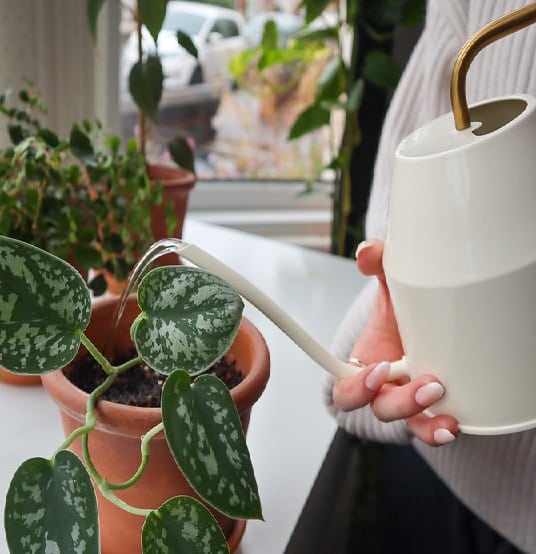
Moreover, Watermelon Peperomia is sensitive to chlorine or fluoride, commonly found in tap water.
It can get brown spots from exposure to fluoride and chlorine.
As a result, it is better to use rainwater or distilled water, or you can also use tap water. However, let the tap water sit for 24 hours before use.
2. Excessive Lighting
Watermelon Peperomias are native to tropical forests, so they prefer a canopy of dispersed light in their natural habitat.
As a result, you must provide bright indirect sunlight.
However, if Watermelon Peperomia receives excessive direct sunlight, its sensitive leaf gets burned, forming brown patches along the leaf edge.
You may notice leaves being crispy dry, and curling as other symptoms, along with brown spots.

Therefore, check if your plant is getting direct sunlight for an extensively long period.
In contrast to excessive sunlight, inadequate sunlight causes shiny silver stripes to fade instead of forming brown spots.
Fixing Lighting Issues
- Begin by removing dark brown leaves, which consume more plants’ energy.
- Relocate them to a shady area until they recover and shift them to a bright indirect sunlit place where the sun shines for at least 5-6 hours.
- Place your Watermelon Peperomia near east or north-facing windows to receive the most optimal amount of sunlight.
- Placing them 3-6 feet away from the south-facing window with a sheer curtain will be efficient.
- You may use grow lights for 10-12 hours to compensate for the absence of sunlight.

Find out more about the best light color for plants.
3. Excessive Fertilization
Generally, Watermelon Peperomia thrives well when provided with balanced 10-10-10 fertilizer monthly.
Due to excess fertilizer, the soil becomes toxic for roots and causes brown spots on leaves. In contrast, inadequate fertilization causes color fade and browning leaves.
Excessive fertilizer causes nutrients to stack up in the soil, i.e., salt build-up, making it toxic for plants.
Salt build-ups are noticeable as they are a whitish layer on top of the soil. They cause dehydration, making leaves brown.
Over-fertilization is indicated by stunted growth, burned or dried leaf margins, wilting breakdown, or plant death.
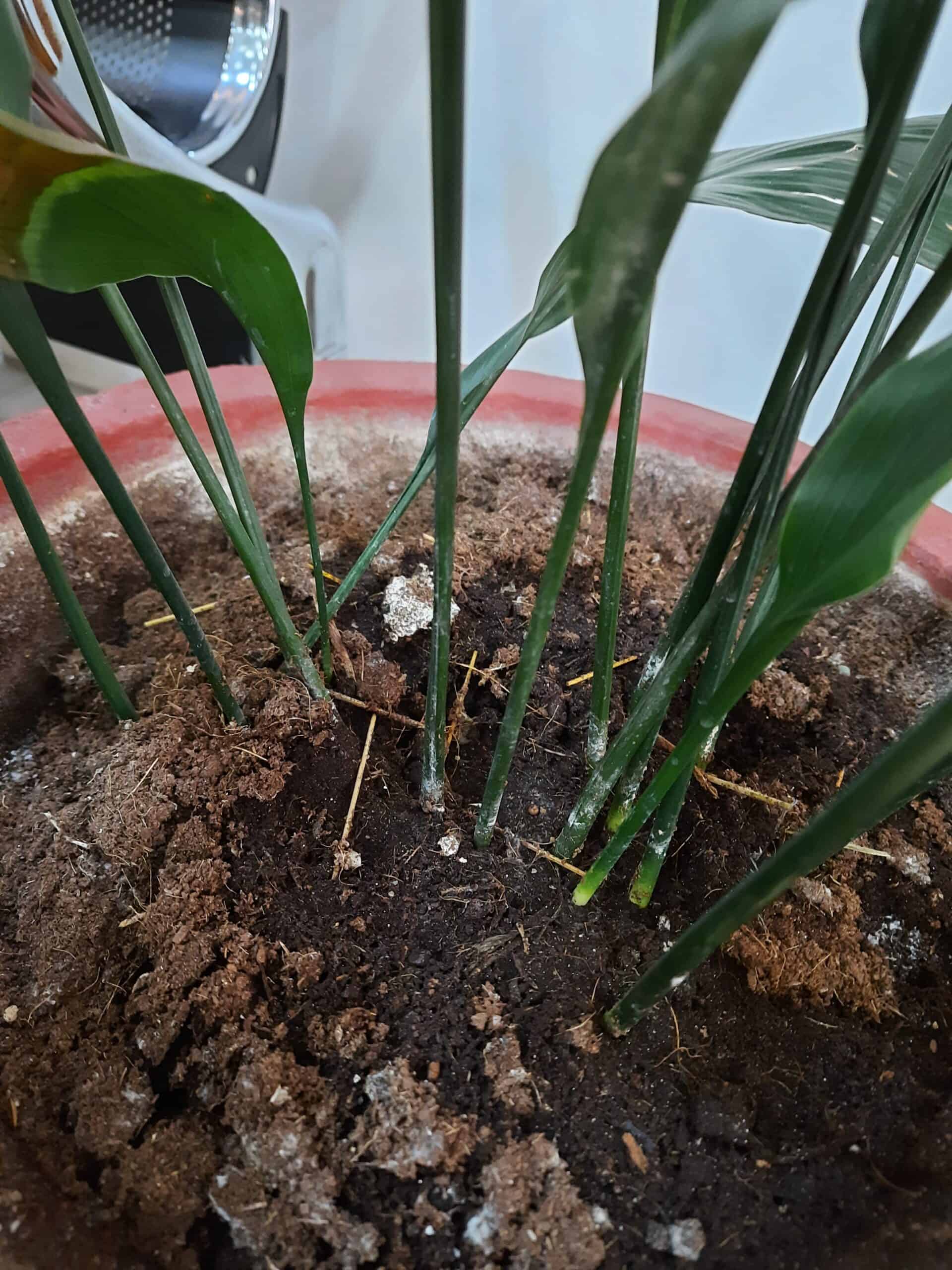
So, try to be cautious about the amount and frequency of your fertilization.
Fixing Over Fertilization Issues
- Wash off the salt build-up using a controlled water stream.
- Completely cut back fertilizing for some time until it gets back to its healthy state.
- If root burn is too severe, repot your plant with a fresh new potting mix after cleaning burnt roots.
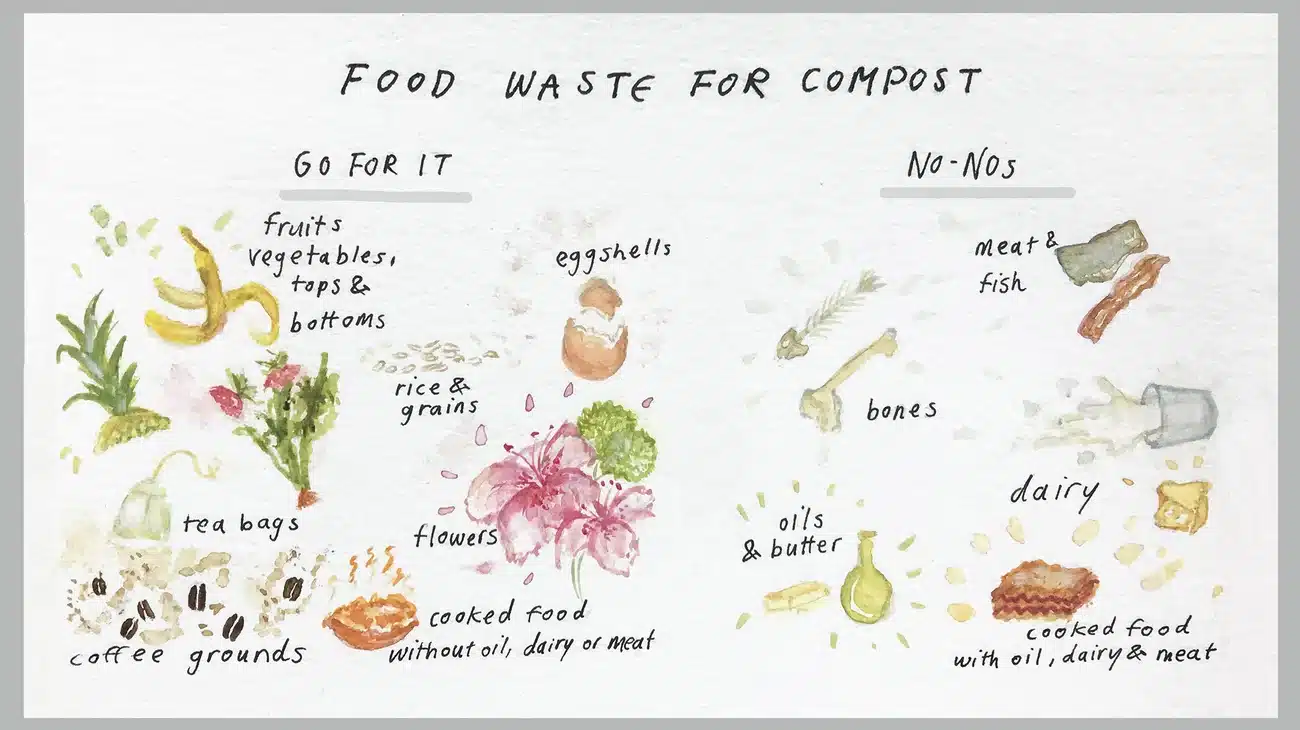
- You can use Osmcote 14-14-14 or Nutricote 13-13-13 to balance excessive salt accumulation.
- Feed your underfed plant with organic fertilizers for a slow and steady recovery.
Pro Tip: Always dilute fertilizers to their half strength before applying them as it ensures no fertilizer burn.
Generally, Watermelon Peperomia prefers monthly organic fertilizers or Nitrogen and Potassium rich synthetic fertilizers.
Moreover, you can use food waste to prepare homemade compost for your plant.
4. Temperature Stress
Watermelon Peperomia is a tropical plant that thrives well in warm indoor temperatures.
Therefore, they do not require an extra heat controller when kept indoors.
A research paper claims that when a plant’s heat tolerance is exceeded, it affects its growth and development and ultimately results in plant death.
When Watermelon Peperomia is kept near AC or radiator, they suffer from temperature stress-causing brown leaves and spots.
The first sign of dehydrated Watermelon Peperomia is browning tips with curled-up leaves caused by excessive transpiration.
Moreover, Watermelon Peperomia exhibits brown spots on leaves when they suffer from a cold draft.

Prolonged sun exposure also induces heat stress on Watermelon Peperomia, resulting in brown spots.
Fixing the Temperature Stress Issues
- Maintain your plant temperature around 60-80°F during the daytime and above 55°F at night.
- Do not place your plants near electric appliances such as heaters, AC, radiators, fireplaces, etc.
- Especially in winter, do not place them near drafty or single-pane windows.
- Use a thermometer to keep an eye on your plants’ temperature.
- Increase watering frequency during summer to balance transpiration.
5. Low Humidity
Generally, Watermelon Peperomia stays happy at an average indoor humidity of ~50%.
When the humidity level drops too low, transpiration rapidly increases, causing dehydration and forming brown spots on leaves.
As a result, you should try to increase the humidity level artificially.
Conversely, higher humidity causes a higher risk of fungal infections like ring spots in your plant.
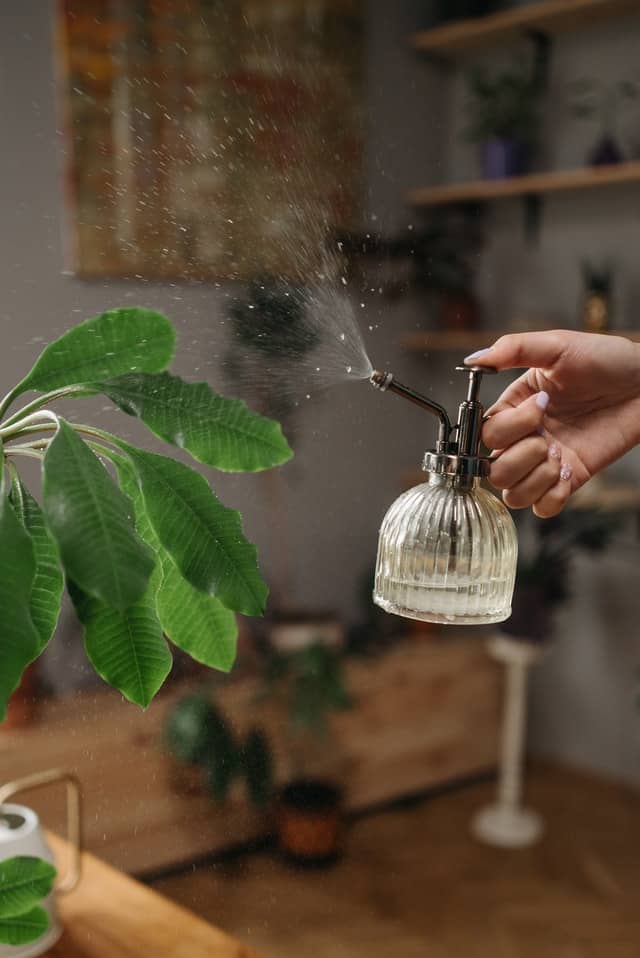
Fixing the Low Humidity Issues
- Place the plant in higher humid areas like the kitchen, bathroom, and laundry room.
- Use a humidifier to keep the humidity as per plants’ needs.
- Mist your plant with a mister in the morning hour.
- Use a pebble tray to place the plants.
- Gather healthy indoor plants together to sustain humidity naturally.
6. Pests Infestation
Pests infestation can also be the reason behind annoying brown spots in Watermelon Peperomia.
Some common pests attacking Peperomia are Mealybugs, Thrips, Spider Mites, and Scales.

These little creatures suck out the plant’s nutrients, leaving worrisome brown patches behind.
Browning spots on the leaves result from the plant’s weak immune system and a lack of nutrition. If not controlled on time, they bear the potential of murdering your plant.
Here are some commons pests along with their symptoms.
| Pests | Signs and Symptoms |
|---|---|
| Mealy buys | White, fuzzy, cottony masses. Stunted plant, yellow leaves. |
| Thrips | Brown, yellow fly-like insects Curled, yellow, or dead leaves. |
| Spider Mites | Tiny yellow-orange with 2 dark spots Webbings develop under leaves. Leaf drooping, wilting, and brown spots. |
| Scales | Cottony, cushion-like insects. Leaf drop, blemishes on leaves |
Treatment Measures
- Isolate the infested plant to prevent it from spreading.
- Remove the infested parts of the plant with sterilized scissors.
- Clean off plant using a water hose to remove all pests, larvae, or eggs.
- Apply alcohol or dish soap using a cotton ball to repel pests.
- Also, apply organic solutions like Neem oil and horticultural oil using a sprayer.
- You can also use yellow sticky traps to capture the pests.
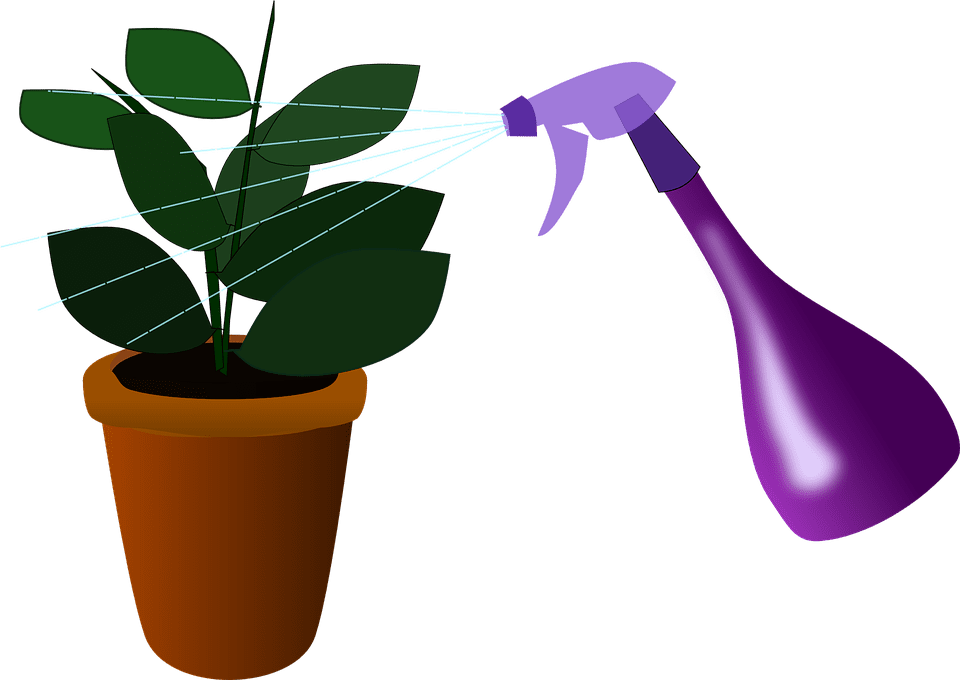
- Lastly, try pesticides like Malathion solution or Pyrethrin spray if nothing works.
- If the condition is beyond help, say goodbye to your plant to keep others safe.
Preventive Measures
- Readily check your plants for common pests and pay attention to previously infected plants.
- Wipe plant leaves clean using a soapy water solution from time to time.
- Plant basil, mint, and rosemary plants near Watermelon Peperomia as they act as a natural pests repellent.
- Ensure to trim off any suspicious yellowing leaves and regularly investigate for unhealthy leaves.
- Avoid overfertilization as they attract more pests.
Learn how to Use Neem Oil on Indoor Plants.
7. Fungal and Bacterial Disease
Fungal and bacterial diseases can also cause brown spots on the Watermelon Peperomia.
Some common fungal leaf spot diseases are Cercospora leaf spot, Phyllosticta leaf spot, and Rhizoctonia leaf spot.
Meanwhile, the Ringspot virus is another behind forming brown spots on Watermelon Peperomia.
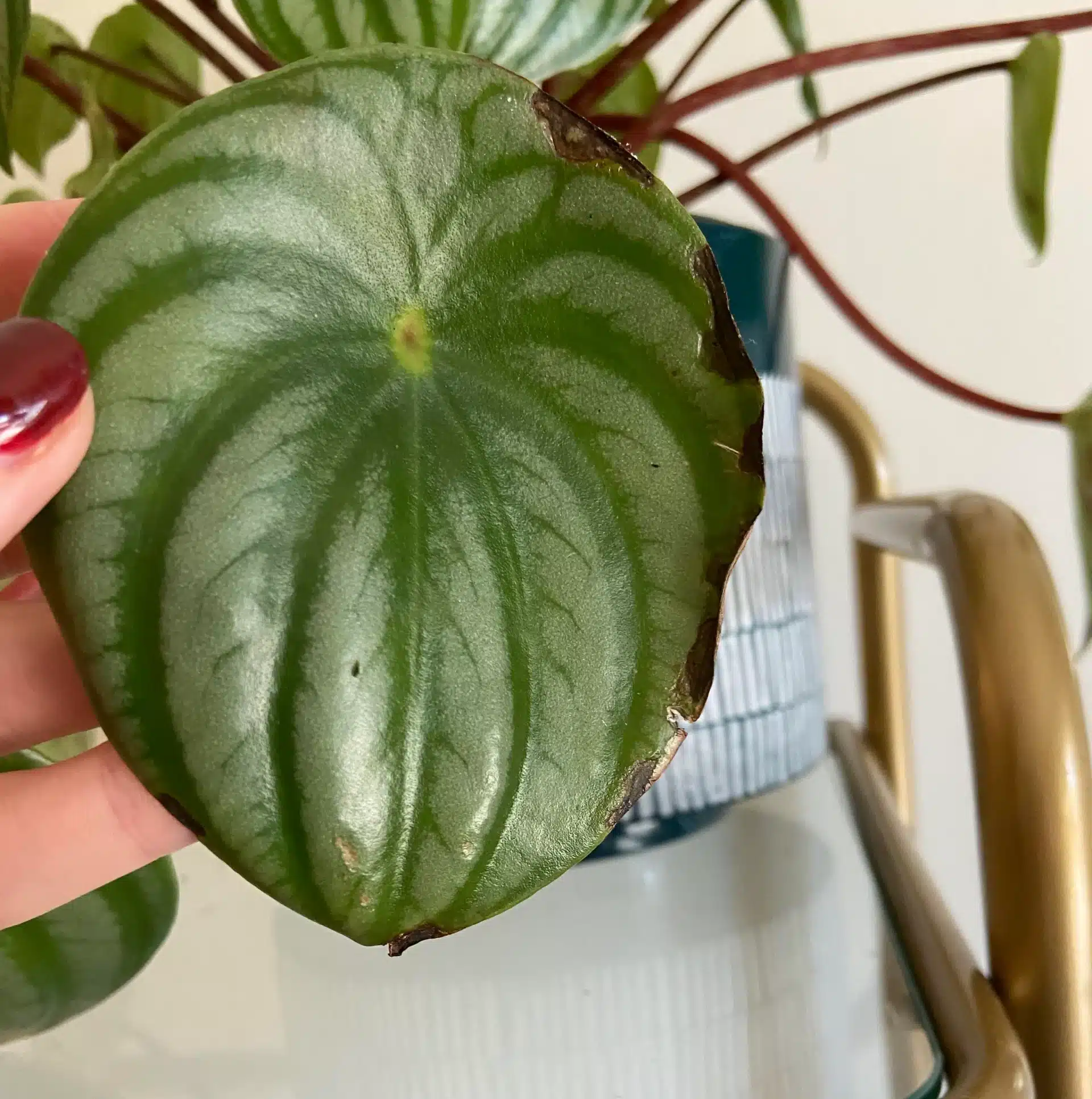
Here is a brief information to help you out with the identification of fungal disease.
| Name of Disease | Symptoms |
|---|---|
| Cercospora leaf spot | Brown or black spots on the bottom of the older leaves |
| Phyllosticta leaf spot | Dark brown to black rings spreading all across the leaf |
| Rhizoctonia leaf spot | Mushy dark brown spots on the plant |
| Southern blight or Sclerotium stem rot | Brown mushy area at the soil line of the cutting |
| Peperomia ring spot virus | Ring of light or dark pigmentation Leaf distortion and stunted plant growth |
| Anthracnose | Withering, wilting and drying plant tissues Dark spots or dark crisscross bars over the leaf |
Ringspot virus causes rings of light or dark pigmentation and leaf distortion, followed by a growth stunt.
Unfortunately, no chemical can control the ringspot viral disease till today.
Therefore, collecting and destroying all the plants is better to control the infestation if you confirm it is a ringspot infection.

Treatment Measures
- Remove infected leaves immediately using sterilized scissors and destroy them.
- Spray neem oils undersides of the leaves where the spores are located.
- Use fungicides like BioAdvanced, Bonide, and Southern Ag per their guidelines.
- Ensure to keep the leaves dry.
- Relocate the plant to a low humid place and cut back watering.
- If the infestation is severe, discard the plant to prevent further spread.
Preventive Measures
- Regularly inspect the plant and properly prune unhealthy yellow leaves or parts.
- Isolate unhealthy and suspicious plants to control spreading.
- Try using the bottom watering method instead of overhead watering.
- Water your plants during the morning hours.
- To maintain the best air circulation, do not overcrowd plants.
8. Compact Potting Mix
Another reason behind brown spots on Watermelon Peperomia can be the wrong potting soil.
Generally, compact soil has poor water infiltration, inadequate aerations, and poor water draining.
According to University of Minnesota, compact soil reduces the rate of water infiltration and drainage, resulting in longer moisture retention and no air circulation.
All of these factors contribute to leaf curling, wilting, and stunted growth, which leads to brown spots on the leaves.
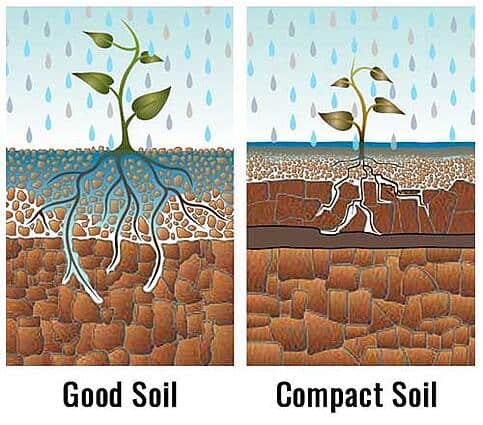
So it is important to choose and prepare the best potting mix for your plant. Furthermore, each plant has a different soil preference.
Repotting your Watermelon Peperomia to a new well-draining potting mix will resolve the problem and restore its health.
You can use light aerated sandy soil with peat moss and vermiculite for your Watermelon Peperomia.
Learn more about Watermelon Peperomia soil requirements.
How to Prevent Watermelon Peperomia Brown Spots?
Here are some tips to avoid brown spots on Watermelon Peperomia.
- Before watering, insert a chopstick into the soil. If one and a half inches of soil is dry, proceed to water.
- Use artificial grow lights for a couple of hours if you’re living in low-light regions or if it is winter.

- Try using organic fertilizers using egg shells, waste vegetables, wood ash, peat, etc.
- If you are placing your plant outdoors, ensure they are under a shade with dappled sunlight.
- Use frost blankets for outdoor plants during winter.
- Regularly, prune away brown, old, decayed leaves in the growing season.
- Consider repotting your Watermelon Peperomia once in every two to three years.
- Wipe clean plant leaves from time to time to discourage any pest infestation.
- Use a proper container with enough drainage holes for your Watermelon Peperomia.
Should you Cut Off Brown Spots of Watermelon Peperomia?
You shall cut off brown spots if they cover more than half of the leaf area as it no longer serves their purpose.
But few brown spots in teeny-tiny size would not hurt the plant as they may form due to minor abruptions in daily needs.
Remember that brown spots that have developed on plant cannot be reversed or fully recovered.
Therefore, cutting them would be the best choice or even be the only option if it is because of fungal or pest infections.
Hence, before you swing the sword, ensure to pinpoint the reason and analyze the situation.
Watch the video for more care tips,
Conclusion
Generally, brown spots on Watermelon Peperomia can be cured when the condition isn’t severe.
However, you can avoid brown spots with timely inspections, appropriate precautions, and a better understanding of plant requirements.
Always provide care and attention to your plants to get rewarded with their aesthetic beauty.
Happy Plant Parenting!
Learn how to keep your Large Watermelon Peperomia happy and healthy.


